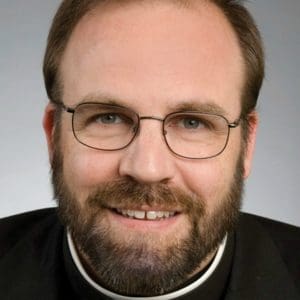There is a kind of tension in some of the imagery we use for God. On the one hand, we call Him the “Unmoved Mover.” We also say that God is everywhere. If He is everywhere then there is nowhere for him to go, no need for Him to move because He is already there. Yet we also speak of “processions” in the Trinity.
St. Thomas artfully and with precision speaks of the Trinity and the two “processions” as Gentori Genitoque laus et jubilation … Procedenti abutroque compar sit laudatio (To the One who generates and to the One who is generated be praise and jubilation … To the One proceeding from them both be equal praise).
St. Thomas also points out an important difference between material procession and divine procession:
In material things, what comes forth from another is no longer in it, since it comes from it by a separation from it in essence or in space. But in God, coming forth does not arise in this way. The Son came forth eternally from the Father in such a way that the Son is still in the Father from all eternity. And so, when he is in the Father, he comes forth. And when he comes forth, he is in him, in such a way that he is always coming forth, and always in him (Commentary on John, 16:28).
So, it would seem that the Unmoved Mover, our Triune God, has processions of love within. There is a kind of dynamism of love! Of course, our feeble words fall short and our analogies are weak.
There is a beautiful Greek word used by the Church Fathers (e.g., St. John Damascene) to describe the inner life of the Trinity: perichoresis. It is a combination of two words: peri, meaning “around” and chorein, meaning “to make space.” Therefore perichoresis, literally translated, means “to make space around.” It points to the way in which someone or something makes space around itself for others or for something else.
What a picturesque word! It suggests a kind of swirling or a dance. It is close in its spelling to the Greek word for dance, choreuo, so many people refer to it as the dance of love in the Trinity. Father, Son, and Holy Spirit make room for one another; they “dance” about and “with” one another in a way that shows a mutual indwelling while still maintaining space for each person.
Yes, love is dynamic. There is a movement of love between the persons of the Trinity. This imagery is powerfully different than the one that most people have of the Trinity (God the Father on one throne, sitting next to His Son on another, with the Holy Spirit hovering like a dove between them). This is not wrong. Scripture speaks of thrones in Heaven and of the Father and the Son seated, but the thrones are likely more an image of authority than of inactivity.
Surely the inner life of the Trinity is more than merely being seated. It is a glorious procession of love: The Father loves the Son, the Son loves the Father, and the Holy Spirit is the love proceeding from them both. Yes, there is a great movement, a dance of love.
To this “dance” of love, Christ draws His Bride, the Church. It is our destiny and dignity to be caught up one day to the great dance of love of the Trinity. Heaven is not a static vision of God from some distance; it is a beatific vision, an experience of love that is dynamic and moving, a dance of ecstasy.
Put on your dancing shoes and get ready for the dance! Remember that to dance well we must surrender all pride and learn to dance as if no one is watching. Only the humble can really dance well, only those who can make space for the Lord and let Him lead.
I hope you will forgive the secular source, but below is an image of Christ drawing His bride to the dance.
Image credit: Depositphotos.
This post was originally published on Community in Mission and is reprinted here with permission.




